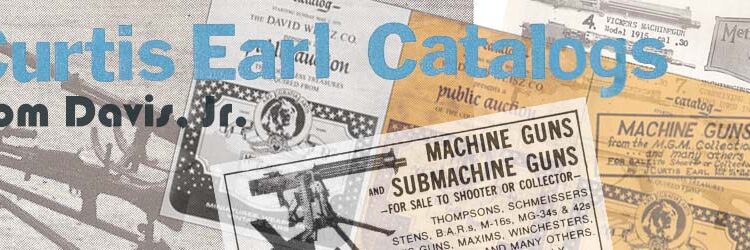By Tom Davis, Jr.
J. Curtis Earl
The passage of the 1934 National Firearms Act created a new class of firearm owners in the United States. It is commonly referred to as the “Class Three” community by those of us that belong. This community started out very small but has since grown to a very respectable size. To those on the outside, it is known by two simple words: machine guns.
When this new community was still in its infancy and the number of Class Three dealers very small, one machine gun dealer soon became somewhat of a national celebrity. That dealer was J. Curtis Earl of Phoenix, Arizona.
Readers of Small Arms Review know the story of J. Curtis Earl because of the excellent three-part story by Richard MacLean featured in the May, July and August 2010 issues. Those new to SAR with an interest in Earl would be smart to order the back issues of this authoritative story or look them up on line at www.smallarmsoftheworld.com.
What brought Earl into such prominence with the American public were his advertisements and catalogs. He certainly understood the value of advertising; his prices for machine guns were at the top of the market. But Earl had something most of his competitors did not have – a very large inventory. Earl showcased this very impressive inventory in a series of catalogs he sold thoughout his career. This story is about the world famous J. Curtis Earl catalogs.
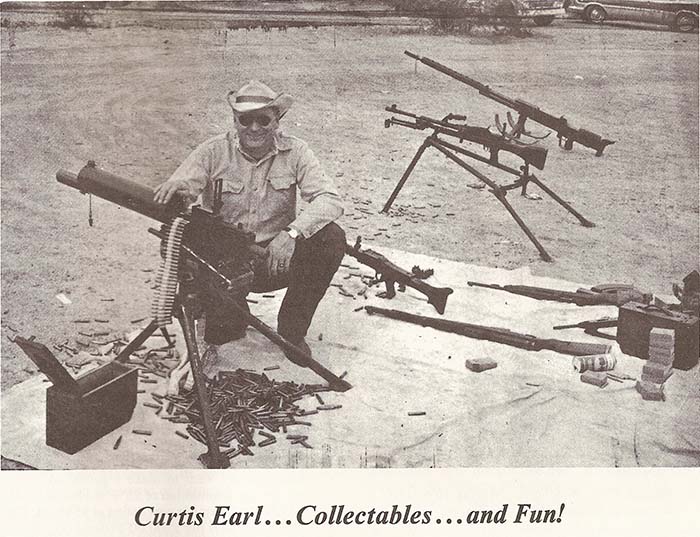
The David Weisz Company and the M.G.M. Weapon Collection
One of the most sought after Earl catalogs is the Metro Golden Mayer (M.G.M.) collection catalog. What is not widely known is that three variations of this catalog exist. It is very possible Earl’s early decision to publish and sell catalogs was influenced by the auction company that sold all the assets of the M.G.M. Studio beginning May 3, 1970 – the David Weisz Company. The David Weisz Company used five catalogs and assorted supplements to advertise and sell the assets of the M.G.M. Studio, including the weaponry. Each catalog was a different color (yellow, blue, green, red and silver) and advertised the many different types of studio assets. The Weisz auction catalogs are now collectibles in their own right. Earl’s first M.G.M. catalog actually copied the cover of the Weisz silver catalog titled, “MINIATURES, WEAPONRY, VINTAGE CARS.” Earl changed the color to yellow and priced this catalog at $1.00 on the first inside white page (page 2). It is 16 pages in length.
This catalog recounts Earl’s purchase of 20 machine guns from the Metro-Goldwyn-Mayer (MGM) studios. His style of advertising to prospective customers is never more evident as in the opening page of this catalog (spelling and grammar mistakes included):
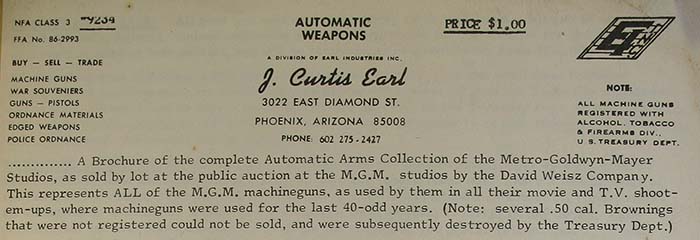
In pricing these guns to you, as the propective buyer and collector, I have given much thought to arriving at a fair and equitable figure on each weapon. Some of these are the rarest of the rare, and as such, discounting any history, are very valuable guns. Other, tho not so rare, rate a certain percentage of value over their counterparts due to their background. The amount of collectors value attributed to this background is best determined by your own eye. Each gun, in its own right, is “one of a kind”. All descriptions are given in full honesty, with these factors, I feel confident that I am giving you full value for your investment dollar, as with the quality and history offered, with all fact considered, you will be getting the most for your money in this type of gun purchase.
The rest of the catalog follows the same style. Included in this lot of machine guns from the M.G.M. studios were five Lewis machine guns, five Vickers machine guns, two Hotchkiss machine guns, two German MG 08/15 machine guns, four Thompson submachine guns and two Reising submachine guns encased in sheet metal to resemble German Schmeisser submachine guns. It is not known why Earl modified the cover on his first M.G.M. catalog by removing the David Weisz Company name. Perhaps, David Weisz objected to how Earl copied his catalog cover or Earl decided to promote his own name and business. It is all speculation now as both Earl (2000) and Weisz (1981) are deceased.

But change the cover he did. The new cover featured a rectangular block angled over the Weisz name titled, “Machine Guns for the M.G.M. Collection…and many others.” It still retained the yellow cover, M.G.M. logo, auction title and the price increased to $1.50. Two variations of this second cover Earl M.G.M. catalog are known to exist. The first variation is 18 pages in length and held together by three staples on the left side. The second variation of the Earl M.G.M. catalog is 20 pages in length. The last page is titled “BROCHURE SUPPLEMENT” and is dated Sept. 10, 1971. This last page is unnumbered and states, “…about one-half of the M.G.M. guns listed have been sold…”
Research for this story revealed the existence of extra pages for the Earl M.G.M. catalogs that have never been stapled into a catalog. It appears likely Earl had extra catalog pages printed and distributed same as customer requests dictated and/or as enclosures with some of his later catalog sales.
Except for the change in the top half of the cover page of the first catalog, all three Earl M.G.M. catalogs are very similar in content. Most changes involve prices or sold notations. Some additional content is added in the later editions.
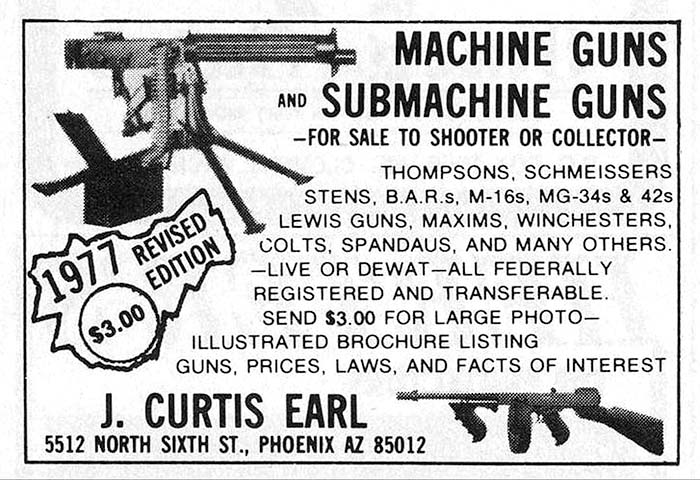
A New Format: $1.50
Earl must have had a very good response in sales from the M.G.M. catalogs because he soon published another catalog. The catalog featured a new format, one Earl would continually refine over the years. This catalog is undated, but does reference a citation to Title 18, U.S. Code, Chapter 44, “Publication #603 dated 6/71” under the caption: STATES LAWS REGARDING MACHINE GUNS. Given that the last page “Brochure Supplement” in the last variation of the Earl M.G.M. catalog is dated September 10, 1971, this most likely makes the publication date in 1972.
The cover featured a picture of a Vickers machine gun and Thompson Submachine Gun with drum but sans butt stock. The title and writings on the cover page will be used on all of Earl’s future catalogs: J. Curtis Earl PRESENTS A BROCHURE OF MACHINE GUNS AND SUBMACHINE GUNS – FOR SHOOTER OR COLLECTOR – Specializing in Thompson Submachine Guns – … with facts, figures and notes of interest on purchasing, shooting and collecting the most interesting and most fascinating of all guns…machine guns.
This catalog is filled with information about the M.G.M. guns and Thompson submachine guns. Six pages are devoted to the acquisition and current sale of the M.G.M. collection. Several pages are copied directly from the Earl M.G.M. catalog. Anyone remotely interested in machine guns, especially the Thompson, would gladly pay $1.50 for what was then a wealth of information. Of course, this wealth of information showcased some misinformation too. Earl’s famous listing of Cutts Compensators showing a “straight, no taper, slip-over fit on front sight” is prominently featured. This compensator type was later debunked by Roger Cox in his now classic 1982 book, The Thompson Submachine Gun. And there is “the bird-teeth rare 25 rd. ball mag.,” another Thompson accessory that existed only in the pages of Earl’s catalogs.
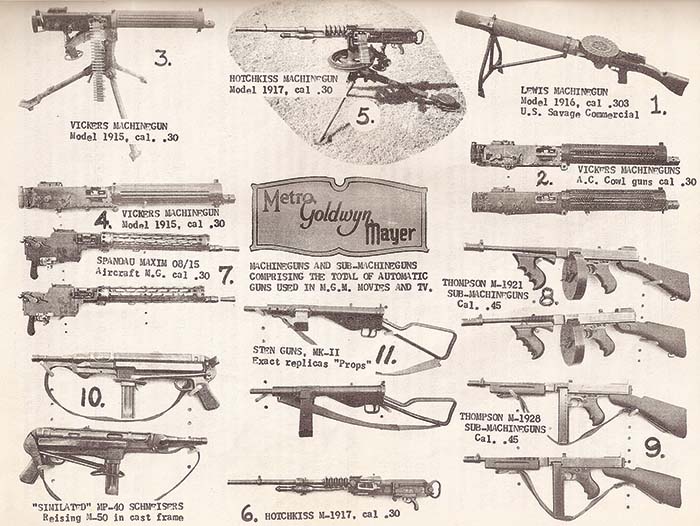
This catalog featured what Earl named the “Midas Thompson,” a fully engraved Colt Thompson with very high grade American walnut stocks. The price was a paltry $5,750. Also featured was the Auto-Ordnance Corporation experimental 9mm Thompson with the distinctive curved magazine, serial number S-1. No price was listed for this fantastic collector’s piece.
Price increase: $2.00
The next catalog, believed to be the 1973 edition, saw a slight price increase. It is almost identical to the $1.50 catalog, above. Most differences involve the layout and use of additional pictures throughout the catalog.
At least two variations of this catalog exist. The catalogs are nearly identical except the first or earliest catalog has a blank back cover page. The later catalog variation has short “Note to Purchasers” and “Note of Interest” statements from Earl on the back cover page. There are also some minor differences on pages 16 and 25.
1974 Edition: $2.00
Earl’s next catalog retained the same cover and price as the earlier edition, above, but was dated – a trend he would continue in some manner with the rest of his catalog editions. This catalog is marked the “1974 Edition” with a copyright of September 1972.
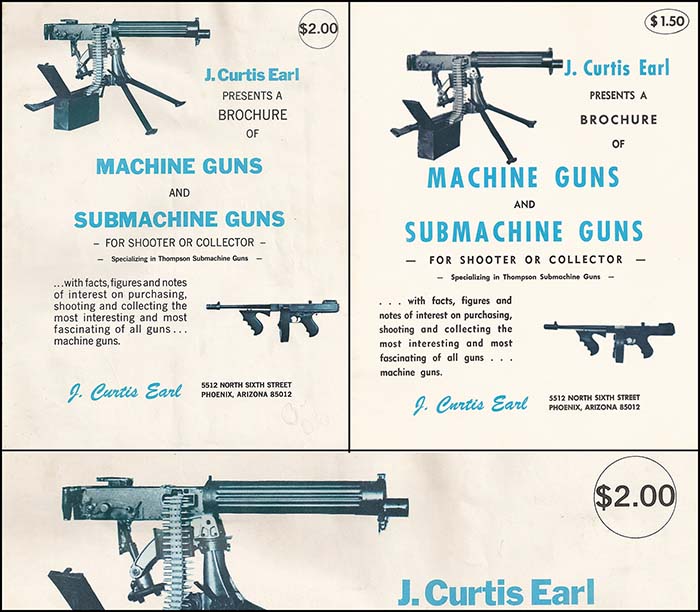
A careful review of this 1974 Edition catalog shows it is almost identical to the earlier undated $2.00 catalogs, above. The copyright September 1972 date is a further indication the first undated catalogs, above, were published in 1972 and 1973. There is a change of some prices as the Midas Thompson apparently had not sold and the price increased to $6,500. What is new is the addition of a yellow four page brochure insert that begins with the word, “Howdy!” Earl then goes on to tell the readers about how the collecting of machine guns is beginning to become more acceptable in America and quotes a July 1973 article from The American Rifleman magazine. Of particular interest in this add-on brochure is information on the Browning and Lewis machine guns obtained from the Savage Arms Company museum. There is also a pair of “NAVY COLT THOMPSONS” with consecutive serial numbers, Nos. 4666 & 4667, for sale as a pair for $5,700.
1975 Edition – $2.50
When opening this catalog it first appears it will be a repeat of the 1974 edition. However, Earl removed three pages of information about the M.G.M. guns and substituted a two page excerpt from the July 1973 article from Guns and Ammo magazine about the Midas Thompson – something that would be used in all of Earl’s future catalogs. Earl further has a caution to prospective buyers that many of the new dealers in the machine gun field are engaging in false advertising, i.e., the dealers do not have in stock many of the guns currently being advertised. One new picture of approximately 35 Thompson guns in a row from the New York State Penal System is very impressive.
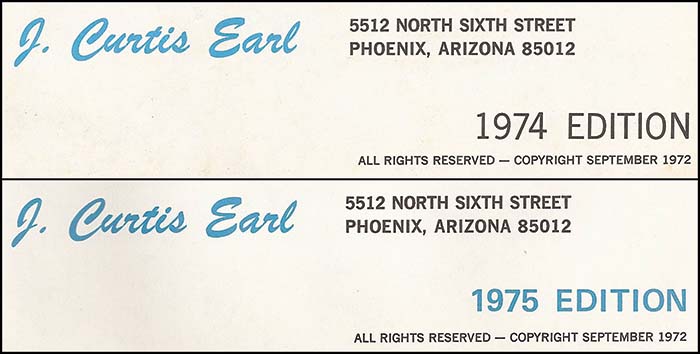
The 1975 edition replaced the yellow brochure insert of the 1974 edition with a blue insert brochure. Except for color, the inserts are almost identical. One of the Browning water cooled machine guns is marked sold, consecutive serial numbers, Nos. 4666 & 4667 are now priced at $6,950 and the Midas Thompson price increased to a whooping $15,000. Earl certainly had the philosophy of increasing the price of a gun until it sold.
Copyright September 1972, 1976 Catalog: $3.50 – Blue Cover
A new cover is featured on the 1976 catalog. Earl is pictured kneeling behind a Browning water cooled machine gun. The cover also shows a Thompson with attached butt stock, German MP 40 and a MAC 10. The cover is blue in color, priced at $3.50, not dated, but notated with the same September 1972 copyright date.
Page 2 features a note from Earl that begins, “Adios, 75! Howdy, ’76” making this the 1976 catalog. He goes on to explain the virtues of collecting machine guns and how the number of machine gun dealers has increased exponentially. Earl’s prediction that the price of the few registered machine guns in America will continue to increase in value and that his “…present stock will not last forever…” was correct.
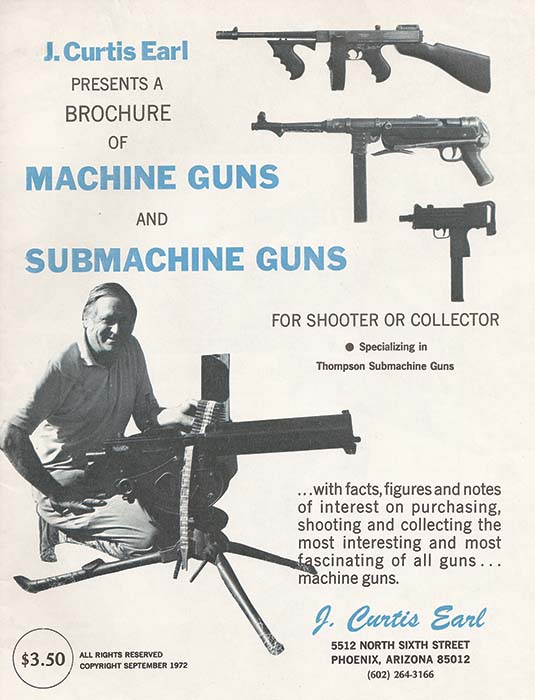
The major revision in this catalog is the removal of the remainder of the M.G.M. pages and the insertion of a two page story on the E.H. de la Garrigue half-scale Thompson submachine guns. This is a must have Earl catalog for the miniature firearm collector. It features excellent pictures; including the famous father and son pose with full size and half size Thompson guns. All models and accessories are discussed and priced for sale.
Much of the content of the yellow and blue brochure inserts are now part of the catalog. The consecutive serial numbered 28 Navy Thompsons, Nos. 4666 & 4667, are listed as P.O.R. or price on request. The Midas Thompson is still priced at $15,000.
Copyright September 1972, 1977 Catalog: $3.50 – Green Cover
In 1977 or 1978, Earl changed the color of the cover of his catalog to green. The copyright September 1972 markings are on the lower left corner of the cover page but there is no date anywhere on or in the catalog. Notwithstanding the fact the catalog is priced at $3.50 on the cover, it is believed this is the $3.00 1977 revision catalog referenced in the Earl advertisement at the beginning of the story. No catalog published by Earl with a $3.00 cover price or date within the 1977 time frame could be located.
As with the blue cover $3.50 catalog, page 2 of the green cover $3.50 catalog features a note from Earl that begins only with, “Howdy.” The message is identical. The blue and green catalogs are basically identical until page 8. The green cover reduces the coverage of the E.H. de la Garrigue half-scale Thompson submachine guns to just a half a page. Added is the cover of the February 1975 GUNS magazine with “THE ROARING TWENTIES” engraved Thompson submachine gun. Also included is a picture of a STEYER-DIAMLER 9mm submachine gun and five pictures of an extensive firearms collection acquired by Earl. The Midas Thompson price has been changed to “$P.O.R.” or price on request. There is also a change to higher prices on many of the firearms listed, i.e., Ingrem (sic) “Police Ordnance” M-6 S.M.G. – “from $600” to “from $800.”
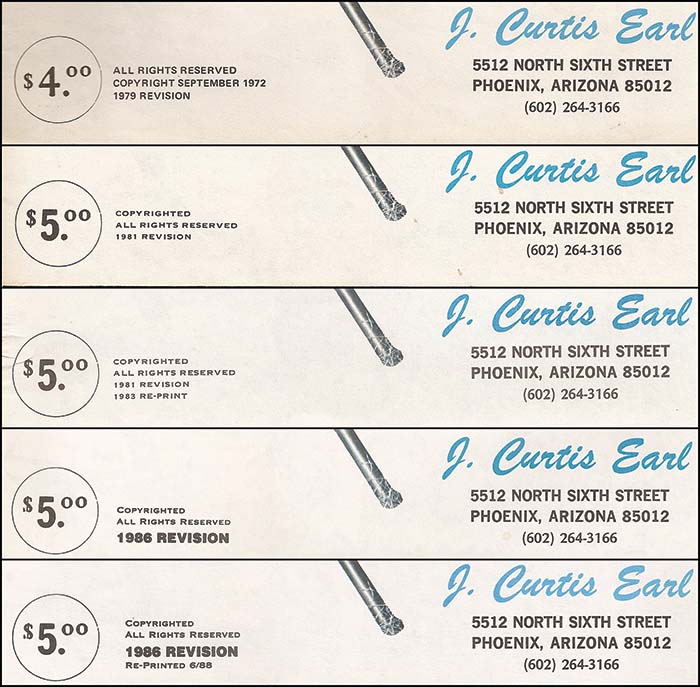
The order of the later catalog pages are also changed between the blue and green cover catalogs but aside from the price increases, the content is the same. As stated above, this catalog is undated, but it does reference a citation to Title 18, U.S. Code, Chapter 44, “Publication #603 dated 6/76” under the caption: STATES LAWS REGARDING MACHINE GUNS. Earl regularly updated this section (the blue cover $3.50 catalog cites Publication #603 dated 6/74) as newer catalogs were published. The June 1976 publication date of Publication #603 lends substantial support to the green cover catalog being the 1977 catalog revision.
Copyright September 1972, 1979 Revision: $4.00
The 1979 Revision catalog brought yet another price increase from Earl. Customers with earlier catalogs could certainly see the similarities in the catalogs as there were no major changes. One interesting note was the two M.G.M. “Schmeissers” made from Reising Model 50 submachine guns, were still in inventory and priced at $650 each. One added headline was Earl had “OVER 150 THOMPSONS NOW IN STOCK.” There are some minor changes on pages 19 and 20 along with price increases throughout this newer catalog. Model of 1927 Colt Thompson Semi-Automatic Carbine, serial number 5252 was priced at $8,750 in the 1977 green cover catalog. The price had now risen to $10,950. MAC-10’s had jumped in price from $450 to $550.
1981 Revision: $5.00
This catalog is identical in most parts to the one above but Earl added two new sections. The first, “News off the top of my head…” is one page of Earl comments concerning the current Class Three market. Comments include the rising number of new machine dealers and the limited availability of inventory, the pitfalls of unregistered guns and a warning about the dewats, re-wats and copies currently on the market. He talks specifically on the MACs and the new Thompsons being manufactured by the “Auto-Ordnance Corp.” Of course, this is the new (at the time) Auto-Ordnance Corporation in West Hurley, New York. Earl states, “It is a new gun, made by cut-corner methods (castings instead of machined steel blocks, with a pot-metal part thrown in too) by people who just use the old name… but come by it honestly, and use it loosely.”
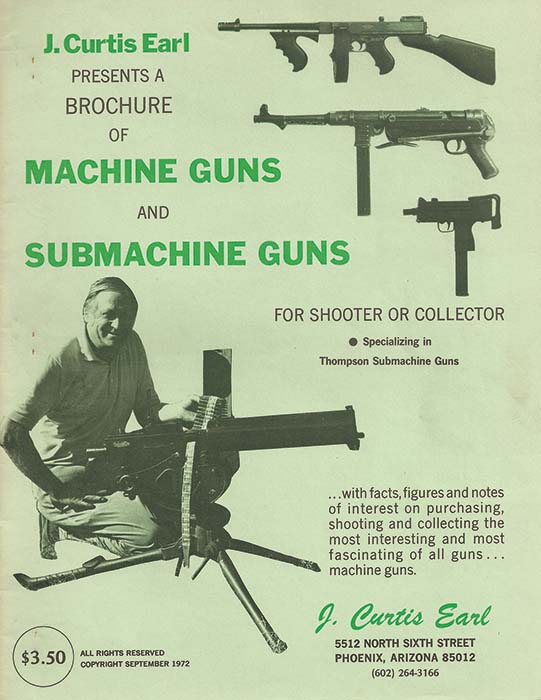
The second new section is a half page titled, “Facts ‘n Figures…..on buying and dealing…..and some general B.S.” This includes information about local laws and the transfer process of a class three weapon. Shipping and Earl’s payment plans are also referenced.
At the end of the catalog Earl includes several new pages with pictures of items for sales of inert explosive devices, smoke grenades, large caliber ammunition rounds and assorted bayonets, pistols, rifles and shotguns.
1981 Revision, 1983 Reprint: $5.00
Earl states in an insert on page 1 that this catalog is a reprint of his 1981 edition catalog with only some minor changes. He says he is down to 950 pieces of inventory and prices have risen considerably. Contained in the catalog is a letter from Earl telling about his new service, the “VIDEO TAPE SHOW-AND-TELL” program. The cost of a video is $75, but Earl will refund $55 of the cost if you return the video to him. The video time is 30 to 90 minutes depending on the customer request, i.e., single gun or all guns within a certain price range.
1986 Revision: $5.00
The 1986 Revision catalog follows the same format as all the previous catalogs but has some changes and updates. It starts off with a new picture of an older Earl on page 1 standing with some of his vast collection. There is a half page devoted to cannons with pictures that will appeal to some collectors. The “News off the top of my head…” section has been updated with a total of 9,100 machine gun dealers in the USA – up from 4,450 in the last catalog. There is a full page of pictures devoted to Earl’s inventory on January 1, 1986. The pictures are very impressive – definitely worth the price of the catalog to a Thompson collector. Earl is down to only 130 Thompson guns in stock – only 130!!! MAC 10s in .45 ACP have risen in price to $1,295; 9mm MAC 10s are $1,595.
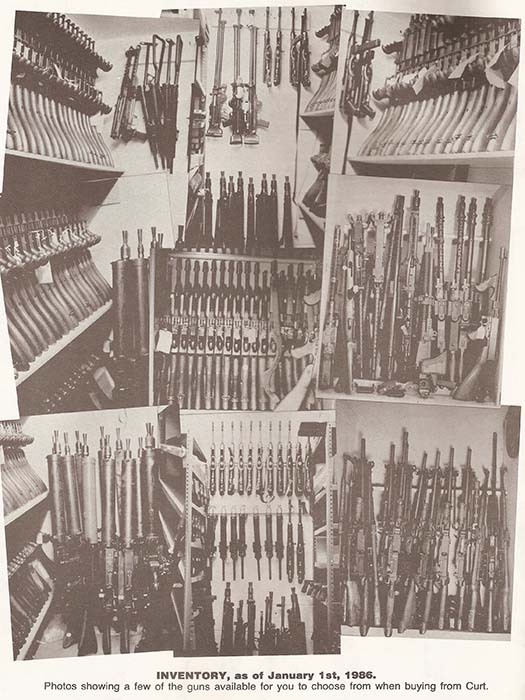
Earl devoted a third of a page to “BUYERS REMORSE.” Apparently, some of his buyers were attempting to back out of sales. Earl repeats: ALL SALES ARE FINAL! The video tape show and tell product information has been incorporated into the catalog. There are other minor changes and a few different pictures. It is quite evident this is a true revision catalog, not a reprint.
1986 Revision, Reprinted 6/88 – $5.00
The June 1988 reprint of the 1986 Revision catalog is the last of the Earl catalogs. It is identical to the 1986 Revision catalog, above. No later edition or dated Earl catalogs have been located. Letters have been found that indicate Earl was still selling catalogs in the late 1990s, but it is believed these were the June 1988 reprinted 1986 Revision catalog. A 1997 letter from Earl to a prospective customer lists a 44 page brochure for $6.50. The June 1988 reprint catalog is 44 pages in length counting the cover and back page (40 numbered pages inside the catalog). As the Earl catalogs become more and more collectible, additional documentation or catalogs may be discovered.
Other flyers and Advertisements
Earl also used gun magazine reprints to advertise certain guns in his inventory. A prime example is the reprint of the July 1973 Guns and Ammo story about the Midas Thompson purportedly written by Earl using the pen name Hank Drake. Earl also used a four page brochure on the E.H. de la Garrigue miniatures Thompson guns that referenced and featured pictures from the February 1976 issue of Gun World magazine.
For Sale – J. Curtis Earl
The business acumen of J. Curtis Earl speaks for itself. And the personality and life style has been well documented. One of Earl’s good friends in his later days was Thompson enthusiast Chuck Olsen. Fortunately, Olsen was able to preserve a lot of documentation related to Earl. One of the documents saved by Olsen was a 1983 spiral bound investment portfolio of Earl’s automatic weaponry business complied by Smira, Olivier and Associates, Phoenix, Arizona. Earl had decided to sell everything and engaged the Smira team to market his complete business. The price for the entire inventory and residence was $1,940,000. This included approximately 800 Title II firearms, approximately 200 Title I firearms, an extensive collection of spare parts, one half million rounds of ammunition and seven cannons.
The portfolio explains Earl’s method of direct advertising by way of a $5 brochure that offers his many guns for sale, to wit, “Depending on the volume of advertising that he orders, he controls the response; thus the amount of sales; and his profits and work involved in acquiring them, Nice, Clean, Efficient, and Lucrative. Over the past fifteen years, he has sent out over 65,000 brochures. At $5.00 per brochure, the brochure alone provides him with a nice profit.” Later, the Financial Section of the portfolio directly references, “Brochure Sales amount to about 3,000 (three thousand) copies being sold a year amounting to an additional $15,000.00 income.” All questions as to why Earl started selling catalogs – answered!
Epilogue
Reading each Earl catalog referenced in this story provided a great deal of information and insight on the Class Three community over an eighteen year period. There is no doubt Earl was a power dealer in this arena. Does this story represent every catalog? No one can say for sure. There is no known master index of every Earl catalog or catalog variation. To that end, if any reader has an Earl catalog that is different from the ones listed in this story, please contact the author via SAR so any new information can be included in any future story.
Author’s Note: The author gratefully acknowledges all the assistance for this story by members of the Thompson Submachine Gun forum at MachineGunBoards.com.
| This article first appeared in Small Arms Review V16N4 (December 2012) |



